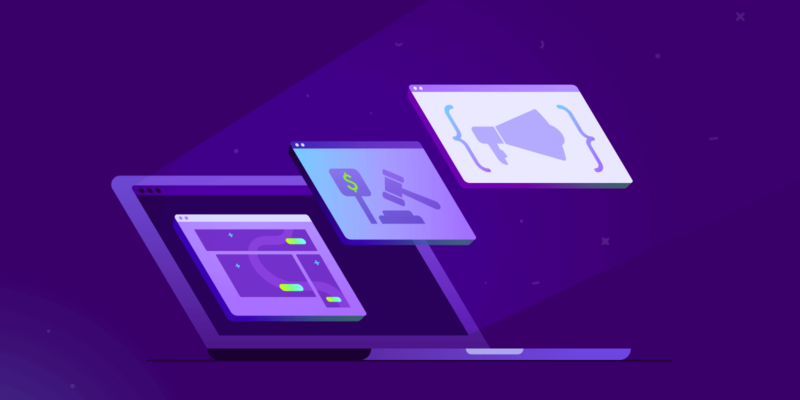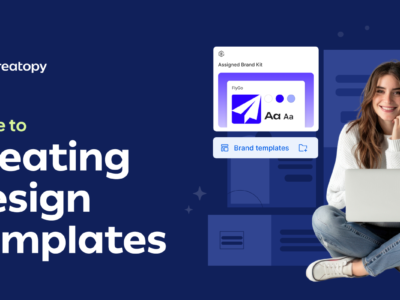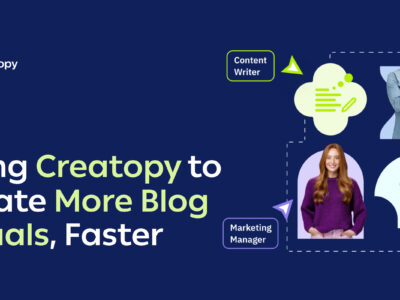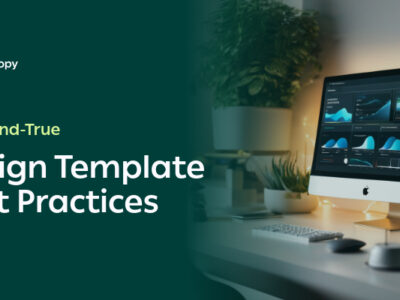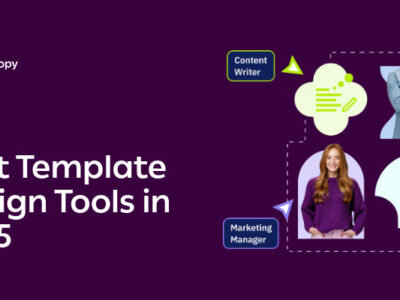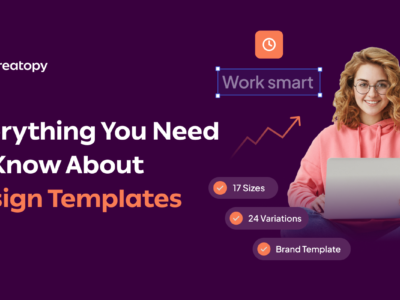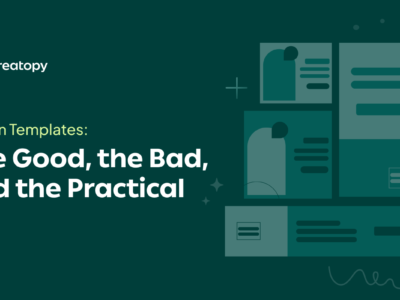The average American is estimated to see up to an overwhelming 10,000 ads daily. Moreover, all of these ads are tailored to each individual. Pretty incredible, right?
Ever wondered how advertisers manage to deliver such a large amount of curated ads on millions of websites and apps?
I have two words for you: programmatic advertising.
I. What is programmatic advertising?
II. How does programmatic advertising work?
III. Brief history of programmatic advertising
IV. Display advertising vs. programmatic advertising
V. Types of programmatic advertising
VI. What are the benefits of programmatic advertising?
VII. What are the challenges of programmatic advertising?
VIII. The future of programmatic advertising
I. What Is Programmatic Advertising?
Programmatic advertising refers to the use of software to automate the process of selling and buying digital ad space.
The concept can be a bit difficult to grasp at first, so let’s expand on this programmatic advertising definition.
There are two big players in the game.
On one side, we have the publishers. They are basically website and app owners with ad inventory they wish to monetize. On the other side stand the advertisers. These are brands or advertising agencies that want to rent digital advertising space from publishers to show relevant ads to their audience.
Both publishers and advertisers combine different technologies to run advertising campaigns automatically. Here are the main platforms in the programmatic ecosystem:
1. Supply-side platforms (SSPs)
Also known as sell-side platforms, they help publishers list, manage and sell their ad inventory on multiple ad exchanges at a time. Google Ad Manager, Amazon Publisher Services, Xandr, and OpenX are the SSPs advertisers use more commonly.
2. Demand-side platforms (DSPs)
They are used by advertisers to set up and manage programmatic campaigns on multiple ad exchanges. A few examples of well-known DSPs are Google Display & Video 360, Amazon Advertising, Roku, and Adform.
Some DPSs can be linked directly to SSPs, but more often than not, the two are linked through an ad exchange.
3. Ad exchanges
These are digital marketplaces that enable publishers and advertisers to buy and sell ad inventory. Google Ad Exchange, OpenX, Rubicon Project, and Xandr are names of popular ad exchanges available right now.
II. How Does Programmatic Advertising Work?
When someone visits a webpage, an ad request containing details about the user, available ad space, and website in case is sent by the publisher’s SSP to an ad exchange or directly to DSPs. You can think of this as an ad for the ad placement (I know, it’s quite meta).
Advertisers’ DSPs analyze the offer using algorithms that determine the value of the ad space based on factors such as campaign allocated budget and audience targeting. If they find it’s a good fit, a bid will be sent to the publisher’s SSP directly or through the ad exchange.
The publisher’s SSP receives multiple offers from various advertisers and ad exchanges simultaneously and picks a winner whose ad is displayed on the website when the page loads.
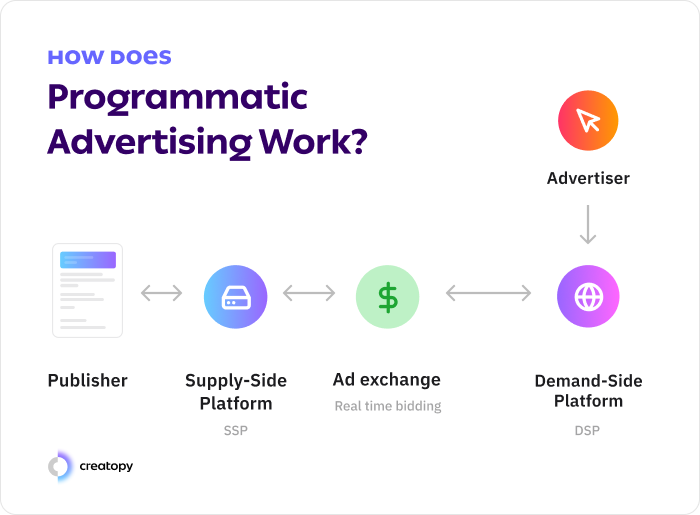
To be fair, this is how real-time bidding works, which programmatic advertising is most often associated with. So much so that there is a common misconception that all ad spaces are traded in real-time.
Not true.
Advertisers can buy ad spaces in real-time auctions as well as directly from publishers. But we’ll explore the different programmatic advertising types later on.
III. Brief History of Programmatic Advertising
The first online ad was published on the internet in 1994. From that moment on, more and more publishers started selling ad space to advertisers.
Of course, at the time, manual direct media buying was the norm, which meant advertisers and publishers had to go through a lengthy process to seal the deal.
The back-and-forth included advertisers preparing and sending offers to publishers, who, in turn, provided information on campaign run dates, available ad placements, and other details. The advertisers would then review these and start potential negotiations.
The ad designers would step in only after the two parties reached an agreement. When the banner ads were ready, the advertiser would send them to the publishers, who—you guessed it—would publish them manually on their websites.
Besides the time-consuming aspect, manual direct media buying generally came with higher costs and a factored-in risk of human error.
As time went by, publishers increased their ad inventory, and this traditional method of transaction just wasn’t cutting it anymore.
In the late 2000s, programmatic advertising started to gain traction, and we saw the first DSPs, SSPs, and ad exchanges. These adtech platforms reduced the need for manual media buying.
Then, in the early 2010s, the growing use of mobile devices urged the widespread adoption of programmatic. Real-time bidding came into play, giving advertisers more control over their ad buying and helping them improve ROI.
Today, most of the ad space is traded programmatically. According to eMarketer, programmatic digital display ad spending in the US surpassed a hundred billion dollars in 2021, growing year-on-year after that.
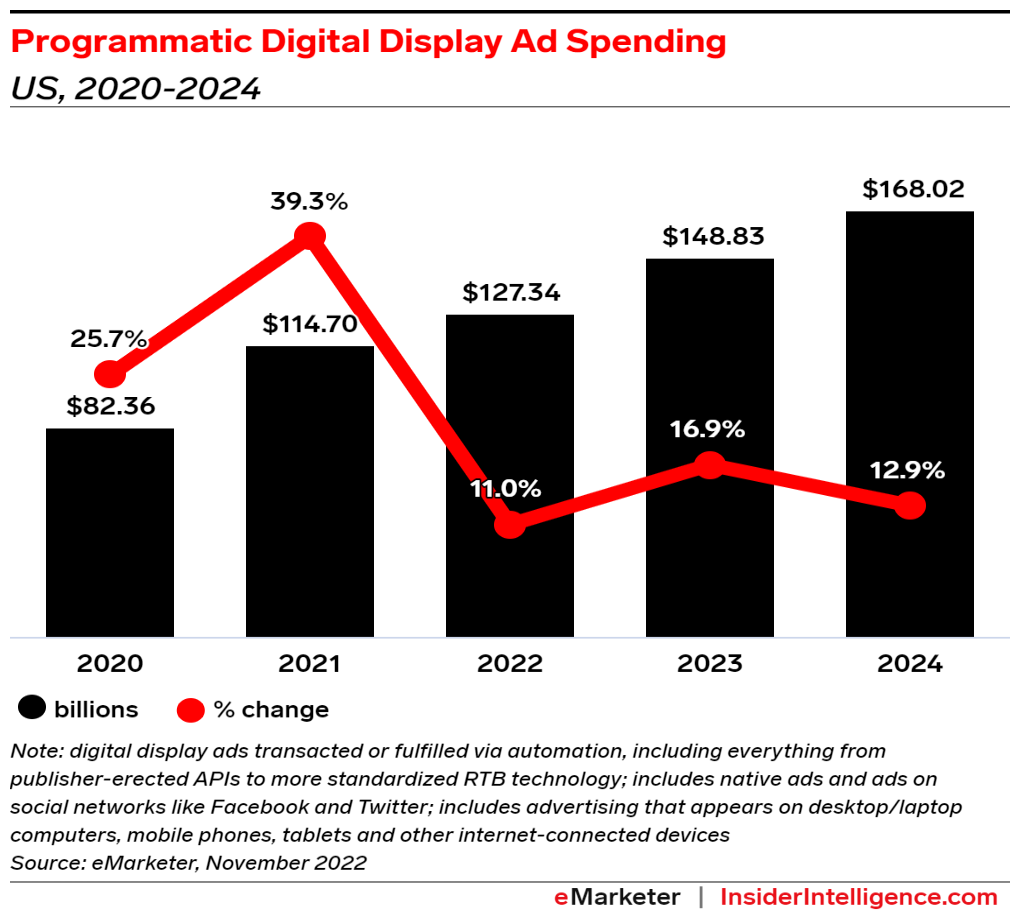
IV. Display Advertising vs. Programmatic Advertising
Advertising beginners can have trouble telling the difference between display ads and programmatic ads, so let’s get that out of the way first:
Programmatic is a way of buying and selling ads.
Display indicates the creatives that are displayed on websites or apps.
Display ads can be delivered programmatically, but also non-programmatically, through advertising platforms like Google Ads. The second method is what is commonly referred to as display advertising.
The two ways of running display ads require different strategies. Let’s take a quick look at what differentiates programmatic advertising from typical display advertising.
| Programmatic advertising | Regular display advertising |
| Cross-platform inventory, wider reach | One ad network’s inventory, limited reach |
| Real-time bidding available | No real-time bidding |
| CPM preferred | CPC, CPM, and CPV |
| Frequency cap by hour & minute | Frequency cap by day |
| Image, video, HTML5, native, rich-media, and audio ads | Image, video, HTML5, and rich-media ads |
| Over 20 targeting methods | Limited targeting methods |
| Dynamic creatives available | No dynamic creatives |
| Open auctions, private auctions, preferred deals, guaranteed deals | No auctions and deals |
V. Types of Programmatic Advertising
There are a few different types of programmatic advertising available to advertisers and publishers. They basically refer to the ways in which programmatic buying can take place. Let’s break them down.
A. Real-time bidding (RTB)
As you can probably tell by the name, real-time bidding allows advertisers to purchase ad space in real time.
We’ve already covered how it works—a virtual auction occurs when a user tries to access a website with available ad space.
Usually, the advertiser with the highest bid wins the auction and gets to have their ad displayed in that spot. But quality score (how well an ad fits with a publisher’s audience and content) plays a part in it too.
What does the highest bid mean? Well, in programmatic campaigns, you pay on a Cost Per Thousand (CPM) impressions basis, so the winner is the advertiser that offers the highest CPM.
This entire process is completely automated and incredibly fast. Everything is done in milliseconds before the webpage even loads.
B. Private marketplaces
Do you want your ads shown in top placements on high-profile websites like The New York Times, CNN, or USA Today? If you gasped and quickly nodded your head, your best bet is to participate in private programmatic marketplaces.
Private marketplaces are basically invitation-based RTBs. They’re organized by publishers trying to sell premium ad inventory directly to advertisers, generally at higher costs.
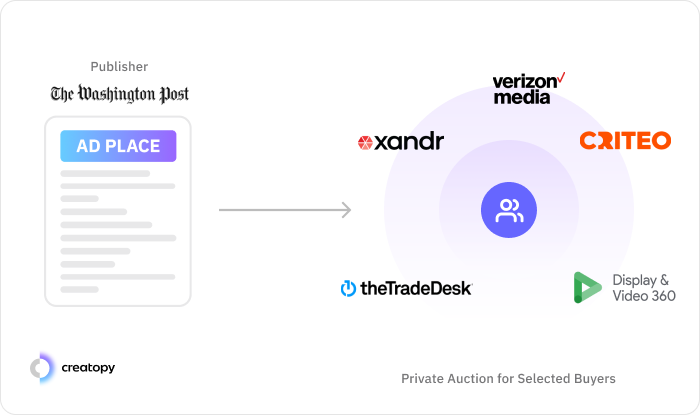
The publisher decides which advertisers participate in their private auction and sets a minimum price floor, meaning advertisers whose bids don’t rise to this amount are not even considered.
Other than that, the auction follows the same course an open RTB would. Advertisers bid through their DSPs, and the highest bid wins the auction.
C. Programmatic direct
Unlike real-time bidding, where many advertisers bid for a publisher’s inventory, programmatic direct is a one-to-one media buying process. The sell-side and the demand-side negotiate on a fixed CPM, and the transaction takes place directly, without ad exchanges.
I know this sounds very similar to the old manual direct media buying methods, but it’s nowhere near as complicated.
Yes, there is human interaction between sales representatives from both sides. Still, the negotiation and campaign setup takes place on a single platform, making things easier and reducing the risk of human error.
Plus, setting up the campaign is a lot faster. You can make the deal and have your campaign up and running on the same day.
D. Programmatic guaranteed
Lastly, we have programmatic guaranteed—another one-to-one media buying transaction in which the sell-side and the demand-side enter an agreement prior to the campaign run.
The advertiser agrees to buy a certain number of impressions, and the publisher agrees to deliver that number of impressions for a guaranteed price. For example, the terms of a guaranteed deal could be to get 50,000 impressions at a CPM of $45.
The setup usually looks like this:
Advertisers typically find publishers through their DSPs and request an offer. Once they receive it, advertisers can either try to negotiate the terms or accept it as is.
When the two find an agreement, the publisher creates a guaranteed deal ID and sends it to the advertisers to target it with the campaign.
A huge advantage of programmatic is that you can target or exclude specific audiences. Let’s say your campaign objective is to attract new website visitors. You can exclude your existing customers to avoid budget waste.
VI. What Are the Benefits of Programmatic Advertising?
These are several advantages the automated media buying process comes with. These can help advertisers put their campaign budgets to great use and achieve their marketing goals more easily. Let’s unpack them together.
A. Efficiency and speed of the process
As you’ve already seen, programmatic media buying moves at the speed of light compared to the old way of buying advertising space. Its efficiency is two-fold. For one, it helps advertisers save time, and two, it takes fewer resources.
Due to its efficiency and high speed, programmatic advertising is also scalable. Advertisers can easily manage multiple campaigns at the same time and take advantage of the cross-platform inventory at their fingertips.
In addition to that, no time is wasted setting up and launching the ad campaigns. This leaves more time for optimization, increasing the chances of better performance and helping campaigns reach their true potential.
B. Data-driven decision-making
Data is critical to the success of programmatic advertising campaigns because it helps advertisers make informed decisions about targeting, measuring, and optimization.
There are three types of data segments you can tap into to get your ads in front of the right people: first-party data, second-party data, and third-party data.
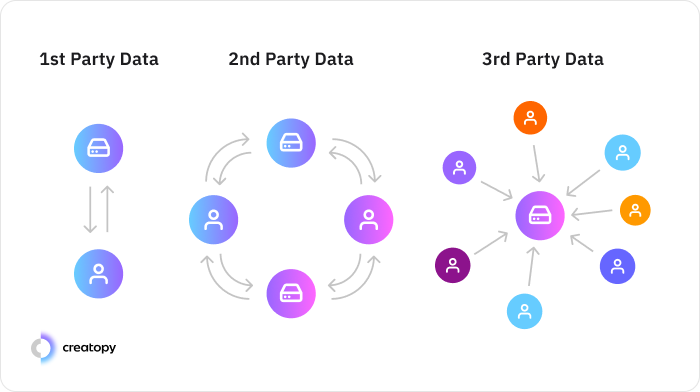
- First-party data is information you collect from your own customers. It can come from CRMs, surveys, social media conversations, or any other type of interaction. When used for programmatic targeting, first-party data helps advertisers find prospects similar to their existing customers.
- Second-party data is user information you borrow or buy from other companies. This secondhand data usually comes from trusty sources that have similar audiences or similar business goals to your own.
- Third-party data is user information you get from companies that collect it from users they don’t have a direct relationship with. DSPs usually have many third-party segments that advertisers can target.
Now, there’s an issue with third-party data. As you probably already know, Apple gave users the choice to opt out of app tracking a few years back. Combined with Google’s decision to phase out cookies in 2024, this will create difficulties.
We can’t know exactly how programmatic targeting will look like when this happens, but there are solutions for navigating the post-cookie marketing landscape. Relying more on first-party data, exploring contextual advertising, or turning to data clean rooms for information are just a few of the alternatives.
From the measuring and optimizing perspective, advertisers get valuable data insights from programmatic campaigns in nearly real-time. They can leverage this information to refine targeting, adjust budgets, and build data-driven creatives.
C. Improved targeting and personalization
Programmatic advertising allows brands to reach more relevant audiences. At the same time, it helps them personalize ads to meet customer expectations.
It makes use of first, second, and third-party data to make sure custom creatives are delivered to the right person at the right time.
There is a multitude of different ways advertisers can target audiences with programmatic, depending on the type of ads they want to run. Let’s take a look at the most common ones for programmatic display:
- Audience targeting relies on demographic information about the users and is the most commonly utilized targeting method;
- Behavioral targeting takes into account information like shopping habits, website interactions, and product interests;
- Contextual targeting uses keywords related to your product or service to place your ads on websites or apps where those keywords appear;
- Cross-device targeting refers to identifying and showing ads to a specific user across multiple devices (e.g. desktop computers, smartphones, and tablets);
- Retargeting means reaching users who previously interacted with your brand or visited your website but did not convert;
- Geo-targeting is basically location-based targeting. This can be done using different information, from city or country to zip code.
Creatopy can also help you deliver personalized ads to users according to their geo-location.
For instance, you can create dynamic ads that change their content based on users’ location.
Imagine you’re running ads for a tourism agency and need to show different offers to people in different parts of the country. Alternatively, this comes in extremely handy with global campaigns—showing different language ad variations according to a location variable.
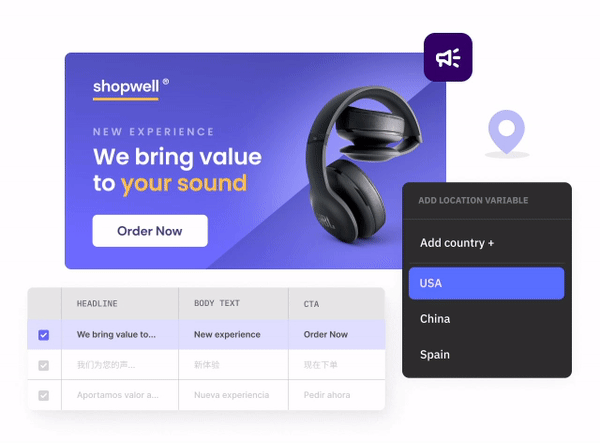
Another possibility is to show ads that automatically change their content based on time and weather conditions.
Let’s say you’re running ads for a restaurant that wants to promote some types of meals at certain moments of the day and according to the weather in the users’ location. You can create a few ad variations, like one for a cold evening, one for a sunny morning, and so on.
It works in the same way for both cases. You create a smart sheet with the conditions for each variation, then upload it on our platform and link the columns with the creative’s elements (headline, image, background), and that’s it. As simple as saying “ad automation.”
Moreover, our ad delivery and optimization add-on enables you to go live with your ads via ad tags across various programmatic advertising networks.
D. Real-time bidding
Real-time bidding (RTB) brings benefits to publishers and advertisers alike, and we’re going to take a quick look at both sides.
For advertisers, RTB means targeting audiences with relevant ads in real time. Since it uses consumer data to tailor the ads to each individual, viewers are more likely to click and convert. This means RTB can also help advertisers achieve a higher return on investment (ROI) for their ad campaigns.
In addition to this, advertisers usually manage to secure more favorable ad space prices in RTBs than in other types of programmatic transactions. Of course, this is highly dependent on real-time market conditions.
For publishers, this type of bidding can be a way to monetize the ad space they don’t sell in private auctions. Plus, they have full control over who advertises on their platforms, having the option to blacklist certain advertisers.
RTB also makes the media buying process faster and more efficient for both the demand side and the supply side. It proves particularly useful when managing various large-scale advertising campaigns across multiple platforms and devices.
E. Cost savings compared to traditional advertising methods
First things first.
Let’s tackle the question that is probably on your mind: how much does programmatic advertising cost?
The answer is how much you want, meaning you don’t necessarily need an extravagant budget to get ROAS. However, it would be best if you considered your company’s budget as a whole, as well as the amount allocated for marketing, which can also be spent on paid search, display, and social ads, besides programmatic.
Still, no matter the budget, when it comes to the almighty dollar, programmatic advertising wins. There are several reasons why it is considered more cost-effective than traditional media buying.
For starters, the media buying process is automated. As a result, costs associated with hiring people to manage the ad campaign are reduced to a minimum.
On top of that, real-time bidding prices are based on supply and demand, which is often more advantageous than buying directly from publishers.
There are also the improved targeting options to consider. They bring more qualified leads by giving more power to the button-of-the-funnel channels and, ultimately, increase the ROI.
VII. What Are the Challenges of Programmatic Advertising?
While programmatic advertising may seem great, and don’t get me wrong—it is, it is not without its challenges. Here are some of the things you should be aware of before diving into the programmatic world:
A. Ad fraud
The automated nature of programmatic advertising makes it vulnerable to ad fraud.
What does ad fraud mean exactly? Well, pretty much any suspicious activity that manipulates aspects of the programmatic ad buying process or the ad campaign metrics for financial gain.
The most common type of ad fraud uses bots to generate clicks for ads published on fraudulent websites. This way, the scammy publisher gets revenue without your ads being clicked on by real users.
Besides botnet traffic, well-known fraud techniques include ad stacking, click hijacking, and pixel stuffing, among many others.
It’s worth mentioning that programmatic campaigns are safer from ad fraud than campaigns delivered via ad networks. Programmatic advertising platforms have integrated fraud prevention systems that include fraud detection algorithms, third-party verification services, and industry standards such as Authorized Digital Sellers for Web (ads.txt) and Authorized Sellers for apps (app-ads.txt).
Advertisers can also do a few things to protect themselves against these malicious threats, such as working only with trusted vendors, checking a domain’s authenticity before running ads there, and keeping track of many different campaign metrics to identify possible fraud.
B. Data privacy and security
Programmatic advertising deals with vast amounts of consumer data. Sensitive personal information on web users is routinely collected for targeting purposes.
Naturally, privacy and security can become significant issues. Even more so in the last year when consumers have become more privacy-aware, and their data security concerns have grown.
As an advertiser, you need to stay up to date and comply with privacy regulations in the states you work in. In the United States, that means the California Consumer Privacy Act (CCPA), and in the European Union, it’s the General Data Protection Regulation (GDPR).
You must also take all necessary precautions to prevent unauthorized access to sensitive information. This can mean things like encrypting data and security testing.
Data breaches are a real threat, one that shouldn’t be ignored. Failing to protect consumer data from security violations may result in financial and legal repercussions not only for advertisers but for publishers as well.
C. Lack of transparency
The traditional direct media buying process was tedious. There’s no doubt about it. But in being handled manually, it had one big advantage that programmatic advertising lacks: publishers and advertisers alike knew how much the media was being sold and purchased for.
The programmatic ad buying transaction offers less visibility because there are so many platforms involved in the process acting as intermediaries (DSPs, SSPs, and ad exchanges).
These “middlemen” collect third-party fees, cutting into advertisers’ campaign budgets. On top of that, there is the matter of ad fraud. The bottom line is that advertisers don’t know exactly how many dollars actually reach publishers.
In 2020, PwC conducted a programmatic supply chain transparency study for the ISBA, which revealed only 51% of advertiser spend actually goes to publishers.
In a second study on the same topic they released at the beginning of this year, the proportion of advertiser spending reaching publishers has risen by 8%.
This suggests digital ad industry is taking slow but steady steps toward supply chain transparency and tracking ad spend.
D. Advertiser’s understanding and adoption
One of the biggest challenges of programmatic advertising, and perhaps the most overlooked one, is the learning difficulty it poses.
Many advertisers struggle with understanding how the programmatic ecosystem works in the beginning. In fact, this is the main reason why some companies decide to outsource some, if not all, parts of the programmatic media buying process.
There are also those who venture into launching their first automated ad campaigns without possessing all the knowledge they need. And hey, this is also an option—if you don’t care about wasting away your budget, that is.
Look, I’m not going to lie to you: programmatic advertising is indeed a complex process involving quite a few new platforms. Still, the good news is that you have all the information you need to run programmatic ads just a few Google searches away.
We’ve also had a webinar on demystifying programmatic advertising that can help you get started. Keep in mind the most important is that you push through the valley of despair before giving up on learning how the programmatic adtech works.
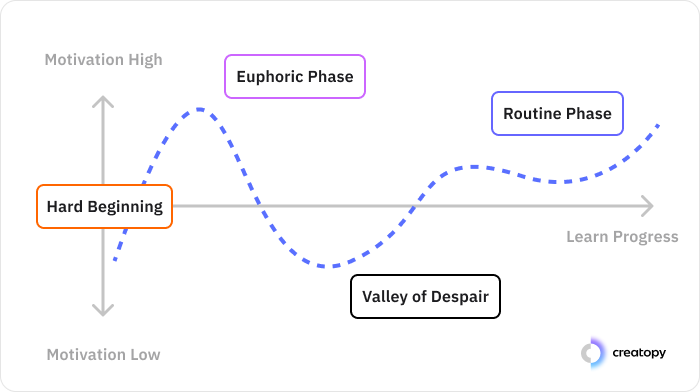
VIII. The Future of Programmatic Advertising
Although marketers expect a decline in programmatic ad spending this year, the future still looks bright. Here are some exciting things advertisers and publishers can look forward to from now on.
A. Integration with emerging trends such as voice and video
The number of people using voice assistants on smartphones and other devices is on the rise, and so are the programmatic advertising opportunities that come with it.
Interactive audio ads or voice-enabled ads have become more common in the past few years and will only grow in popularity in the future. For instance, Alexa-connected devices let users reply following an ad’s call-to-action. Consumers can get chatty about different products or brands and take steps towards acquisition on the spot, hands-free.
Programmatic video ad buying is also surging, which is not at all surprising considering how much video content people consume. This year’s programmatic video ad spending will represent 55.4% of the total programmatic digital display ad spending, only to rise to 57.7% in 2024.
Connected TV (CTV) and over-the-top (OTT) platforms allow advertisers to expand their reach and get their ads in front of relevant audiences.
More and more houses can be reached through CTV, so this programmatic sector is also expanding. Just last year, Google announced it’s unlocking even more CTV inventory in Display & Video 360 and allowing advertisers to target viewers on connected devices using Google audiences.
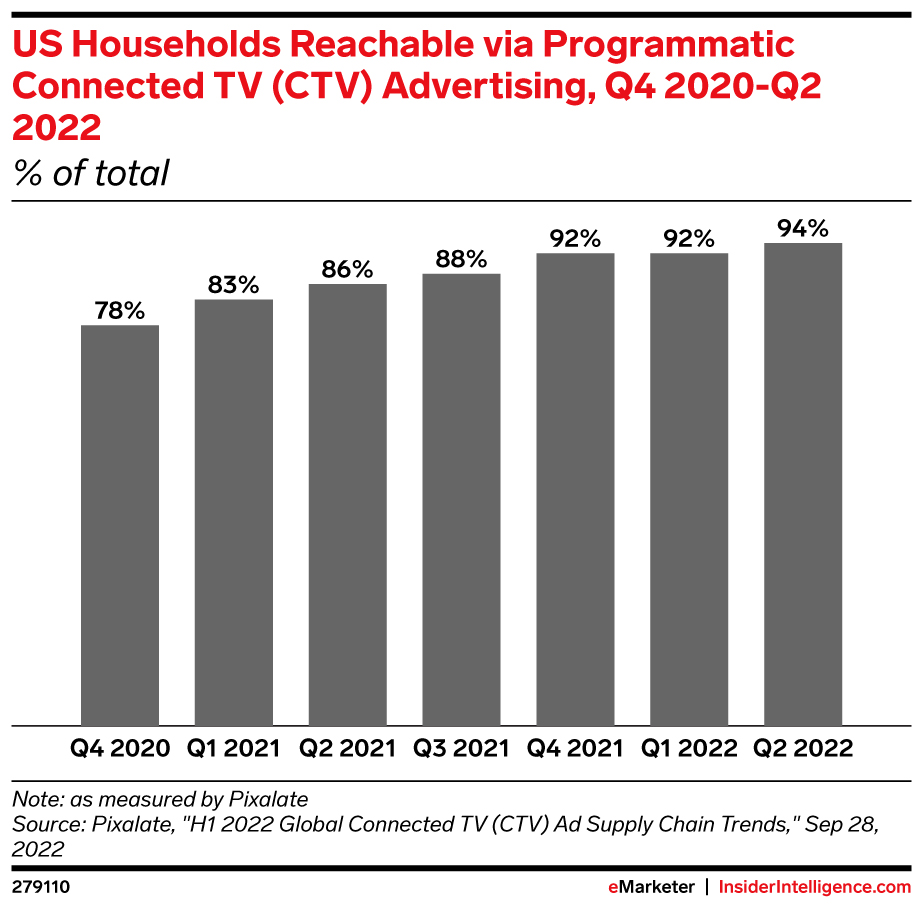
You can run video ads on a wide array of streaming platforms, such as Hulu, Disney Plus, and Roku. Plus, as of November 2022, Netflix ads can be purchased programmatically through Xandr’s demand-side platform.
Programmatic digital out-of-home ads (DOOH) are right up there with the other trends we just mentioned. These are basically OOH ads that use the power of programmatic, which opens up many possibilities, like displaying ads on certain billboards at certain hours for limited amounts of time, showing different ad variations depending on weather conditions, and so on.
Just imagine your brand’s animated ad on a huge billboard in the middle of a traffic jam. Guaranteed exposure.
B. The role of machine learning and AI
Machine learning is a subset of AI that plays an important role in the programmatic ad buying process.
How?
Well, programmatic advertising is powered by huge datasets that need interpreting. This part of the process is automated with the help of machine learning algorithms focused on predictive analysis.
This technology is able to draw conclusions from data quickly and contribute to the success of an ad campaign. These are a few different ways in which they do this:
- Identifying patterns in user behavior and predicting future actions. For example, if someone searches for “midi skirts” on Google, they are likely to click on an ad showing this type of product or even make a purchase;
- Estimating the most favorable value for a bid depending on the possibility of a user clicking on that ad;
- Analyzing campaign performance metrics and making adjustments for improved results. The algorithms also learn from each campaign and know which optimizations will likely make the following ones more successful.
We should also address the elephant in the room: generative AI. ChatGPT, DALL-E, and co. are all the rage right now. The question is: do they fit anywhere in the programmatic space?
Our answer is “sort of.” These tools can help you get ad design and ad copy ideas for programmatic campaigns, but we don’t recommend you use the results as they are.
AI copywriting tools have limited information which can easily translate to inaccurate outputs, and generative AI designs still raise copyright issues.
C. The impact on the traditional advertising industry
Programmatic advertising is gaining momentum. Compared to what it has to offer right now, traditional advertising can seem a bit outdated. I mean, few advertisers would say no to using sophisticated targeting methods to reach the right audience on a broad range of channels with personalized ads, don’t you think?
Still, will programmatic eradicate non-programmatic/display advertising? It’s highly unlikely, at least not for the foreseeable future.
Regardless of how efficient and fast programmatic media buying is, it’s automated, and that might not sit well with advertisers who prefer to have more control over their ad campaigns. That, alongside the lack of transparency and the risk of fraud we discussed, can be dealbreakers.
However, there are constant advancements in technology, and these present issues might soon become a thing of the past. Only time will tell.
IX. Conclusion
And that brings us to the end of the article. I hope you found it helpful and feel confident you have the knowledge and skills to tackle programmatic marketing. For those of you who are still on the fence about it, let’s go over the main ideas once more.
A. What to keep in mind
Programmatic advertising is buying and selling digital ad space through automated methods.
The process is much more efficient than manual direct media buying. In addition, it comes with advanced audience targeting capabilities, facilitates data-driven decision-making, and brings cost savings.
Although this adtech is not short of advantages, it also poses a few challenges like ad fraud and lack of transparency. However, the positive outweighs the negative.
B. The significance of programmatic advertising in today’s digital landscape
Programmatic advertising has had a powerful impact on the digital advertising industry so far and will continue to do so in the following years.
The reason it’s becoming more and more widespread is that it gives businesses a competitive edge, allowing them to make data-driven decisions and optimize their campaigns to achieve a higher ROI.
C. Final thoughts and recommendations for advertisers and marketers
Contrary to popular belief, programmatic advertising can bring great results on all budgets. This means you can get with the program (pun intended) as a small business or a large-scale enterprise and be successful.
You could argue that creating many ad variations to resonate with different audiences is costly and time-consuming. While this can certainly be the case, some tools can help you scale up the ad creation process without eating away at your budget. Creative automation is key.

